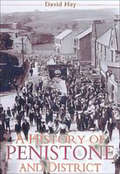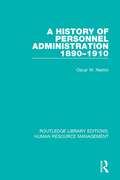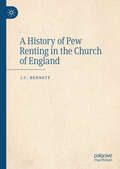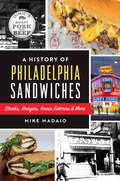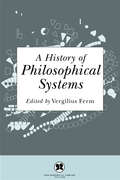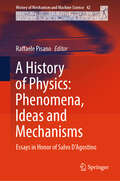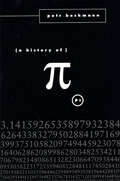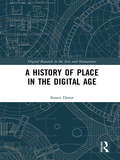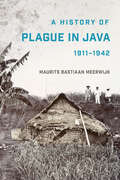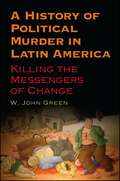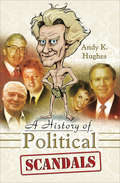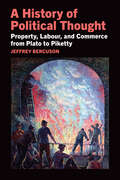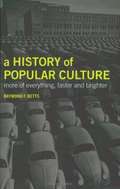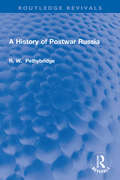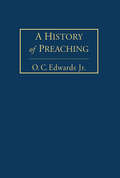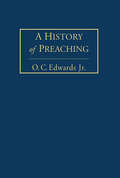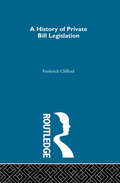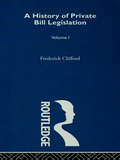- Table View
- List View
A History of Penistone and District
by David HeyThis highly informative book covers the history of the ancient parish of Penistone from early times to the present day and combines a scholarly account with personal memories of the district in the 1940s. Much of the character of the ancient parish of Penistone was formed in the 19th century, when textile mills, steel works and the railways provided work for the growing population.
A History of Personality Psychology: Theory, Science, and Research from Hellenism to the Twenty-first Century
by Frank DumontFrank Dumont presents current personality psychology with a fresh description of its current status as well as its prospects. Play, sex, cuisine, creativity, altruism, pets, grieving rituals, and other oft-neglected topics broaden the scope of this fascinating study. This tract is imbued with historical perspectives that reveal the continuity in the evolving science and research of this discipline over the past century. The author places classic schemas and constructs, as well as current principles, in the context of their socio-political catalysts. He further relates this study of the person to life-span developmental issues and to cultural, gender-specific, trait-based, genetic/epigenetic, and evolutionary research findings. Personality psychology has recently reconciled itself to more modest paradigms for describing, explaining, and predicting human behaviour than it generated in the 19th and 20th centuries. This book documents that transformation, providing valuable information for health-service professionals as well as to teachers, researchers, and scientists.
A History of Personnel Administration 1890-1910 (Routledge Library Editions: Human Resource Management)
by Oscar W. NestorThis study, first published in 1986, examines and evaluates the personnel techniques and activities that were characteristic of one period in American industrial life. In later years these techniques and activities came to be known as personnel management or personnel administration. By these terms is meant the policies, procedures, and programs that were introduced by companies for the purpose of bringing about constructive and harmonious relationships between management and its own employees. This title will be of interest to students of business studies and human resource management.
A History of Pew Renting in the Church of England
by J.C. BennettThis book is a comprehensive study of the history of pew-renting in the church of England, from the first known rented sittings in the fifteenth century to the system’s collapse in the twentieth. The book’s significance is partly its originality; no book and very few articles or portions of books have appeared solely on pew-renting since the nineteenth century, and even those of that time were not histories – they were polemical works that generally attacked pew-renting on religious grounds. This work encompasses the distinction between formal letting of seats – which involved the methodical letting of sittings by church authorities with set rents – and informal pew-letting, in which congregants tipped pew-openers and sidesmen for favourable seats for one service. It also details the concomitant difficulties and hindrances encountered by churches and renters, the means of setting the rents and collecting the proceeds, the types of congregants who rented pews, thecontroversy the practice provoked, and the deception and bending – and sometimes outright breaking – of the applicable law.
A History of Philadelphia Sandwiches: Steaks, Hoagies, Iconic Eateries & More (American Palate)
by Mike MadaioTake a Bite of Philadelphia's Storied Sandwich History Philadelphia boasts some of the most delicious original sandwiches and passionate sandwich aficionados. From the classic cheesesteak to the delectable roast pork, the city's cultural and ethnic diversity has resulted in many of America's most established meals between bread. Join author and bona fide sandwich obsessive Mike Madaio as he journeys through the history and eateries behind Philadelphia's most iconic sandwiches and discovers some unsung heroes along the way.
A History of Philosophical Systems
by Vergilius FermEditor Vergilius Ferm brings together the theories of over forty-one prominent philosophers in this well-organized and thoughtful overview of philosophical systems. You'll find compelling entries from each school of thought including Buddhist and Christian philosophies, Positivism, Phenomenology, Evolution, and more. This text, which includes the work of philosophers from ancient Greece all the way up to twentieth-century thinkers, is the perfect companion to any serious student of philosophy. Vergilius Ferm is the author of several reference titles in philosophy, including Dictionary of Pastoral Psychology and A History of Philosophical Systems. He taught at the College of Wooster, where he served as the head of the Department of Philosophy.
A History of Physics: Essays in Honor of Salvo D'Agostino (History of Mechanism and Machine Science #42)
by Raffaele PisanoThe book gathers several contributions by historians of physics, philosophers of science and scientists as new essays in the history of physics ranging across the entire field, related in most instances to the works of Salvo D'Agostino (1921-2020), one of the field's most prominent scholars since the second half of the past century. A phenomenon is an observable measurable fact, including data modelling, assumptions/laws. A mechanical phenomenon is associated to equilibrium/motion. Are all mechanisms mechanisms of a phenomenon? Scholars with different backgrounds discuss mechanism/phenomena from an historical point of view. The book is also devoted to understanding of causations of disequilibrium (shock, gravitational, attraction/repulsion, inertia, entropy, etc.), including changes/interaction in the framework of irregular cases of modern physics as well. The book is an accessible avenue to understanding phenomena, ideas and mechanisms by leading authorities who offer much-needed historical insights into the field and on the relationship Physics–Mathematics. It provides an absorbing and revealing read for historians, philosophers and scientists alike.
A History of Pi
by Petr BeckmannThe history of pi, says the author, though a small part of the history of mathematics, is nevertheless a mirror of the history of man. Petr Beckmann holds up this mirror, giving the background of the times when pi made progress -- and also when it did not, because science was being stifled by militarism or religious fanaticism.
A History of Place in the Digital Age (Digital Research in the Arts and Humanities)
by Stuart DunnA History of Place in the Digital Age explores the history and impact of Geographic Information Systems (GIS) and related digital mapping technologies in humanities research. Providing a historical and methodological discussion of place in the most important primary materials which make up the human record, including text and artefacts, the book explains how these materials frame, form and communicate location in the age of the internet. This leads in to a discussion of how the World Wide Web distorts and skews place, amplifying some voices and reducing others. Drawing on several connected case studies from the early modern period to the present day, the spatial writings of early modern antiquarians are explored, as are the roots of approaches to place in archaeology and philosophy. This forms the basis for a review of place online, through the complex history of the invention of the internet, in to the age of the interactive web and social media. By doing so, the book explores the key themes of spatial power and representation which these technologies frame. A History of Place in the Digital Age will be of interest to scholars, students and practitioners in a variety of humanities disciplines with an interest in understanding how technology can help them undertake research on spatial themes. It will be of interest as primary work to historians of technology, media and communications.
A History of Plague in Java, 1911–1942
by Maurits Bastiaan MeerwijkIn A History of Plague in Java, 1911–1942, Maurits Bastiaan Meerwijk demonstrates how the official response to the 1911 outbreak of plague in Malang led to one of the most invasive health interventions in Dutch colonial Indonesia. Eager to combat disease, Dutch physicians and officials integrated the traditional Javanese house into the "rat-flea-man" theory of transmission. Hollow bamboo frames and thatched roofs offered hiding spaces for rats, suggesting a material link between rat plague and human plague. Over the next thirty years, 1.6 million houses were renovated or rebuilt, millions more were subjected to periodic inspection, and countless Javanese were exposed to health messaging seeking to "rat-proof" their beliefs along with their houses.The transformation of houses, villages, and people was documented in hundreds of photographs and broadcast to overseas audiences as evidence of the "ethical" nature of colonial rule, proving so effective as propaganda that the rebuilding continued even as better alternatives, such as inoculation, became available. By systematically reshaping the built environment, the Dutch plague response dramatically expanded colonial oversight and influence in rural Java.
A History of Polar Exploration in 50 Objects: From Cook’s Circumnavigations to the Aviation Age
by Anne StrathieA History of Polar Exploration in 50 Objects covers just over 150 years of polar exploration during which a mysterious southern continent and an elusive northern sea-route became less incognita and increasingly charted and understood. The objects of the title include instruments used by explorers and scientists, their means of transport and representations of previously unrecorded sights and creatures. Others evidence how explorers financed expeditions, survived during them or shed light on the lives of those who awaited their return in an era before the modern communications now taken for granted. While individual objects are of their own time, they form part of a continuum of polar exploration; they also evidence networks and collaborations which bind polar explorers and scientists to each other, to other mariners and those living in or near polar regions. The 50 objects include: • Mrs. Elizabeth Cook's ditty-box made of wood from HMS Resolution. • John Ross's long-preserved canister of meat • A rock marker left by James Clark Ross for his best friend, 'Frank' Crozier • John Rae's surveying octant • Edward Wilson's portable paintbox • Ernest Shackleton's 'Farthest South' sledging-compass • A samurai sword • Matthew Henson's North Pole expedition fur suit • Roald Amundsen's fjord-side refuge • HMS Erebus's long-silent bell Some objects remain in polar regions, others are in public spaces, museums, archives and galleries all over the world. They and the stories relating to them are illustrated with almost 150 images, some rarely or not previously published. A History of Polar Exploration in 50 Objects is Anne Strathie's fourth book on polar regions and is the culmination of approaching fifteen years of research and travel in polar regions and in Britain and other countries lying between the two extremes.
A History of Political Murder in Latin America: Killing the Messengers of Change (SUNY series in Global Modernity)
by W. John GreenThis expansive history depicts Latin America's pan-regional culture of political murder. Unlike typical studies of the region, which often focus on the issues or trends of individual countries, this work focuses thematically on the nature of political murder itself, comparing and contrasting its uses and practices throughout the region. W. John Green examines the entire system of political murder: the methods and justifications the perpetrators employ, the victims, and the consequences for Latin American societies. Green demonstrates that elite and state actors have been responsible for most political murders, assassinating the leaders of popular movements and other messengers of change. Latin American elites have also often targeted the potential audience for these messages through the region's various "dirty wars." In spite of regional differences, elites across the region have displayed considerable uniformity in justifying their use of murder, imagining themselves in a class war with democratic forces. While the United States has often been complicit in such violence, Green notes that this has not been universally true, with US support waxing and waning. A detailed appendix, exploring political murder country by country, provides an additional resource for readers.
A History of Political Scandals: Sex, Sleaze And Spin
by Andy K. HughesA must-have guide to the scandalous behavior of politicians around the world. Andy Hughes&’s fascinating book guides us through centuries of political abuse—and just plain stupidity. This pocket guide exposes the secret side of politics, including politicians who risked or ruined their own careers for personal gain. Stories include the MP who liked to party hard and be whipped even harder; the prime minister and his hookers; expenses claims for manure; and the US president who called for all gay men to be castrated. Politicians have mixed scandal with eggs, adult movies, helicopters, drugs, shoes, beef burgers, public toilets, mobile phones, rape, turkeys, orgies, and even ice cream. And it&’s not just today&’s politicians who are embroiled with scandal. This explosive book reveals the questionable behavior of politicians of yesteryear from around the world.
A History of Political Science (Elements in Historical Theory and Practice)
by Mark BevirThis Element denaturalises political science, stressing the contestability and contingency of ideas, traditions, subfields, and even the discipline itself. The history of political science is less one of scholars testing and improving theories by reference to data than of their appropriating and transforming ideas, often obscuring or obliterating former meanings, to serve new purposes in shifting political contexts. Political science arose in the late nineteenth century as part of a wider modernism that replaced earlier developmental narratives with more formal explanations. It changed as some scholars yoked together behavioural topics, quantitative techniques, and positivist theory, and as other scholars rejected their doing so. Subfields such as International Relations remained semi-detached and focused on policy as much as theory. Furthermore, the shifting fashions within political science – modernism, behaviouralism, realism, neoliberalism, the new institutionalism – have informed the policies by which governments have tried to tame contingency and govern people.
A History of Political Thought in the Sixteenth Century [Revised Edition]
by Prof. J. W. AllenFirst published in 1928, this presentation of the main phases and features of political thought in the sixteenth century was based on an exhaustive study of contemporary writings in Latin, English, French, German and Italian. The book is divided into four parts, with the first part dealing with the new thought of Protestantism. The rest describes in turn special ideas that emerged in England, in France and in Italy at the time of original publication.This 1957 edition includes revised and updated Bibliographical Notes.
A History of Political Thought: Property, Labor, and Commerce from Plato to Piketty
by Jefferey BercusonA History of Political Thought is an accessible introduction to the history of political and economic thought; its main focus is the rise, and eventual consolidation, of modern market society. It asks: What are the effects of private property and commerce on individual well-being and on the stability of the political community? A History of Political Thought answers this central question through the careful study of political philosophers and economists, from ancient Greece to the twenty-first century. The book does not have an ideological agenda and gives equal voice to thinkers on opposite sides of the political spectrum. This is one of its key merits and a mark of distinction: its willingness to treat stark opponents – Hobbes and Locke, Smith and Marx, Keynes and Hayek, among others – as equally worthy of serious study. In doing so, the book provides students with a very powerful arsenal of ideas about the evolution of the market and also provides a solid introduction to the history of political thought.
A History of Popular Culture: More of Everything, Faster and Brighter
by Raymond F. Betts Lyz BlyThis lively and informative survey provides a thematic global history of popular culture focusing on the period since the end of the Second World War. A History of Popular Culture explores the rapid diffusion and 'hybridization' of popular culture as the result of three conditions of the world since the end of World War Two: instantaneous communications, widespread consumption in a market-based economy and the visualization of reality. Betts considers the dominance of American entertainment media and habits of consumption, assessing adaptation and negative reactions to this influence. The author surveys a wide range of topics, including: the emergence and conditions of modern popular culture the effects of global conflict the phenomenon and effects of urbanization the changing demography of the political arena and the work place the development of contemporary music culture film, television and visual experience the growth of sport as a commercial enterprise. Now updated, by Lyz Bly, to include major developments such as blogs and social networks, YouTube.com, and enhanced technologies such as the iPhone, iPod, and iPad as well as the way in which the internet has reshaped the ways we consume media. The book provides an engaging introduction to this pervasive and ever-changing subject.
A History of Popular Culture: More of Everything, Faster, and Brighter
by Raymond F. BettsThis lively and informative survey provides a thematic global history of popular culture focusing on the period since the end of the Second World War. Raymond Betts considers the rapid diffusion and "hybridization" of popular culture as the result of three conditions of the world since the end of World War Two: instantaneous communications, widespread consumption in a market-based economy and the visualization of reality. Betts considers the dominance of American entertainment media and habits of consumption, assessing adaptation and negative reactions to this influence. The author surveys a wide range of topics, including the effects of global conflict, the effects of urbanization and the growth of sport as a commercial enterprise.
A History of Portugal and the Portuguese Empire
by A. R. DisneyThe Kingdom of Portugal was created as a by-product of the Christian Reconquest of Hispania. With no geographical raison d'être and no obvious political roots in its Roman, Germanic, or Islamic pasts, it for long remained a small, struggling realm on Europe's outer fringe. Then, in the early fifteenth century, this unlikely springboard for Western expansion suddenly began to accumulate an empire of its own, eventually extending more than halfway around the globe. The History of Portugal and the Portuguese Empire, drawing particularly on historical scholarship postdating the 1974 Portuguese Revolution, offers readers a comprehensive overview and reinterpretation of how all this happened - the first such account to appear in English for more than a generation. Volume I concerns the history of Portugal itself from pre-Roman times to the climactic French invasion of 1807, and Volume II traces the history of the Portuguese overseas empire.
A History of Portuguese Overseas Expansion 1400-1668
by Malyn NewittA History of Portuguese Overseas Expansion 1400-1668 provides an accessible survey of how the Portuguese became so influential during this period and how Portuguese settlements were founded in areas as far flung as Asia, Africa and South America. Malyn Newitt examines how the ideas and institutions of a late medieval society were deployed to aid expansion into Africa and the Atlantic islands, as well as how, through rivalry with Castile, this grew into a worldwide commercial enterprise. Finally, he considers how resilient the Portuguese overseas communities were, surviving wars and natural disasters, and fending off attacks by the more heavily armed English and Dutch invaders until well into the 1600s. Including a detailed bibliography and glossary, A History of Portuguese Overseas Expansion 1400-1668 is an invaluable textbook for all those studying this fascinating period of European expansion
A History of Postwar Russia (Routledge Revivals)
by Roger PethybridgeFirst Published in 1966, A History of Postwar Russia covers sixteen years of Soviet history, from the closing stages of the Second World War (1945) until the Twenty-second Soviet Party Congress (1961), dealing with both domestic and foreign policy and their influence on each other. It aims at giving the overall shape of Soviet history in these years. The author argues that in Soviet society each sector of activity must be viewed in relation to the whole, so that the monolithic pattern of totalitarian politics can be appreciated. More than any other major power, the Soviet Union did not submit easily to compartmentalized study, since every branch of Soviet life was carefully trimmed to grow towards the Communist aim. This book is an essential read for scholars and researchers of Soviet history, Soviet politics, European history, Russian history, and comparative politics.
A History of Preaching Volume 1
by O.C. Edwards JR.A History of Preaching brings together narrative history and primary sources to provide the most comprehensive guide available to the story of the church's ministry of proclamation. Bringing together an impressive array of familiar and lesser-known figures, Edwards paints a detailed, compelling picture of what it has meant to preach the gospel. Pastors, scholars, and students of homiletics will find here many opportunities to enrich their understanding and practice of preaching. Volume 1 contains Edwards's magisterial retelling of the story of Christian preaching's development from its Hellenistic and Jewish roots in the New Testament, through the late-twentieth century's discontent with outdated forms and emphasis on new modes of preaching such as narrative. Along the way the author introduces us to the complexities and contributions of preachers, both with whom we are already acquainted, and to whom we will be introduced here for the first time. Origen, Chrysostom, Augustine, Bernard, Aquinas, Luther, Calvin, Wesley, Edwards, Rauschenbusch, Barth; all of their distinctive contributions receive careful attention. Yet lesser-known figures and developments also appear, from the ninth-century reform of preaching championed by Hrabanus Maurus, to the reference books developed in the thirteenth and fourteenth centuries by the mendicant orders to assist their members' preaching, to Howell Harris and Daniel Rowlands, preachers of the eighteenth-century Welsh revival, to Helen Kenyon, speaking as a layperson at the 1950 Yale Beecher lectures about the view of preaching from the pew. Volume 2, available separately as 9781501833786, contains primary source material on preaching drawn from the entire scope of the church's twenty centuries. The author has written an introduction to each selection, placing it in its historical context and pointing to its particular contribution. Each chapter in Volume 2 is geared to its companion chapter in Volume 1's narrative history. Ecumenical in scope, fair-minded in presentation, appreciative of the contributions that all the branches of the church have made to the story of what it means to develop, deliver, and listen to a sermon, A History of Preaching will be the definitive resource for anyone who wishes to preach or to understand preaching's role in living out the gospel. "...'This work is expected to be the standard text on preaching for the next 30 years,' says Ann K. Riggs, who staffs the NCC's Faith and Order Commission. Author Edwards, former professor of preaching at Seabury-Western Theological Seminary, is co-moderator of the commission, which studies church-uniting and church-dividing issues. 'A History of Preaching is ecumenical in scope and will be relevant in all our churches; we all participate in this field,' says Riggs...." from EcuLink, Number 65, Winter 2004-2005 published by the National Council of Churches
A History of Preaching Volume 2
by O.C. Edwards JR.A History of Preaching brings together narrative history and primary sources to provide the most comprehensive guide available to the story of the church's ministry of proclamation.Bringing together an impressive array of familiar and lesser-known figures, Edwards paints a detailed, compelling picture of what it has meant to preach the gospel. Pastors, scholars, and students of homiletics will find here many opportunities to enrich their understanding and practice of preaching.Ecumenical in scope, fair-minded in presentation, appreciative of the contributions that all the branches of the church have made to the story of what it means to develop, deliver, and listen to a sermon, A History of Preaching will be the definitive resource for anyone who wishes to preach or to understand preaching's role in living out the gospel.Volume 2 contains primary source material on preaching drawn from the entire scope of the church's twenty centuries. The author has written an introduction to each selection, placing it in its historical context and pointing to its particular contribution. Each chapter in Volume 2 is geared to its companion chapter in Volume 1's narrative history.Volume 1, available separately as 9781501833779, contains Edwards's magisterial retelling of the story of Christian preaching's development from its Hellenistic and Jewish roots in the New Testament, through the late-twentieth century's discontent with outdated forms and emphasis on new modes of preaching such as narrative. Along the way the author introduces us to the complexities and contributions of preachers, both with whom we are already acquainted, and to whom we will be introduced here for the first time. Origen, Chrysostom, Augustine, Bernard, Aquinas, Luther, Calvin, Wesley, Edwards, Rauschenbusch, Barth; all of their distinctive contributions receive careful attention. Yet lesser-known figures and developments also appear, from the ninth-century reform of preaching championed by Hrabanus Maurus, to the reference books developed in the thirteenth and fourteenth centuries by the mendicant orders to assist their members' preaching, to Howell Harris and Daniel Rowlands, preachers of the eighteenth-century Welsh revival, to Helen Kenyon, speaking as a layperson at the 1950 Yale Beecher lectures about the view of preaching from the pew."...'This work is expected to be the standard text on preaching for the next 30 years,' says Ann K. Riggs, who staffs the NCC's Faith and Order Commission. Author Edwards, former professor of preaching at Seabury-Western Theological Seminary, is co-moderator of the commission, which studies church-uniting and church-dividing issues.'A History of Preaching is ecumenical in scope and will be relevant in all our churches; we all participate in this field,' says Riggs...." from EcuLink, Number 65, Winter 2004-2005 published by the National Council of Churches
A History of Private Bill Legislation: (2 Volume Set)
by Frederick CliffordThis is Volume II of two of a history of the private bill legislation originally published in 1887. Meant by the author as serving as a Jubilee record of the Queen Victoria’s reign, it covers the topics of highways, the water supply of London from the seventeenth century, local authorities before and after the Conquest, corporation of the City of London, Marine life and fire insurance, the Docks on the Thames, Fees on private bills and preliminary inquiries and public legislation.
A History of Private Bill Legislation: (Vol 1 of 2 Vols)
by Frederick CliffordFirst published in 1968. Routledge is an imprint of Taylor & Francis, an informa company.
